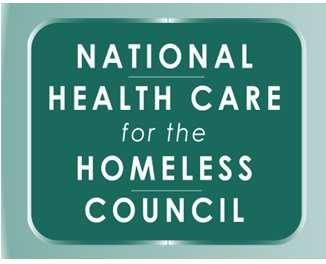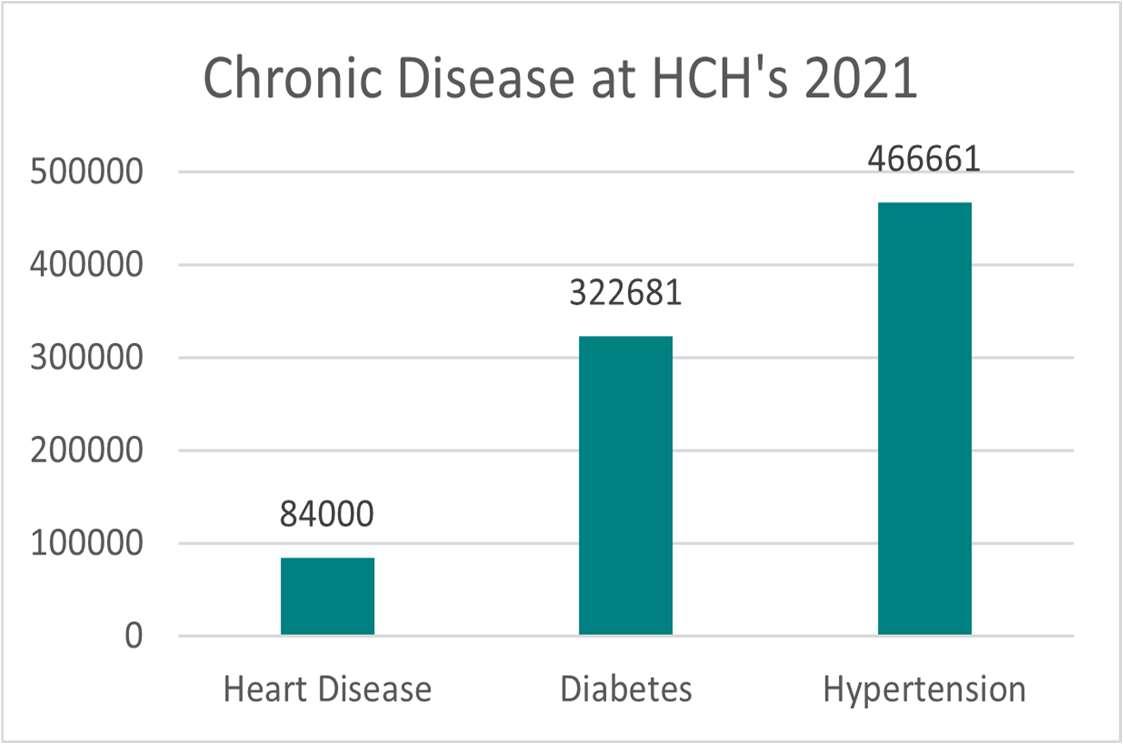Chronic Disease among People Experiencing Homelessness

June2023
Heart disease and diabetes are significant health concerns among the homeless population in the United States. Homelessness exacerbates the risk factors and challenges associated with these conditions, leading to poorer health outcomes and increased mortality rates. This fact sheet provides an overview of heart disease and diabetes within the homeless community, highlighting key statistics, risk factors, and potential strategies for intervention.
Heart Disease in the Homeless Community:
Prevalence:

Persons experiencing homelessness (PEH) have a significantly higher prevalence of heart disease compared to the general population.
Health center programs that receive specific funding to provide services to PEH (330h funded health centers, also referred to as Health Care for the Homeless or HCH) saw 322,681 patients for diabetes and 84,000 for heart disease in 2021.

Studies indicate that rates of heart disease among PEH are two to three times higher than in the general population.
Heart disease is a major cause of morbidity and mortality among adults experiencing homelessness.
Heart disease is the leading cause of death among homeless men.
Men 45 to 65 years old are 40-50% more likely to die of heart disease.
Risk Factors:
Substance Abuse: Substance use, including tobacco, alcohol, and illicit drug use, is prevalent among PEH and contributes to the development of heart disease.
Poor Nutrition: Limited access to healthy food options and inadequate nutrition contribute to the development of heart disease.
Mental Health Conditions: Higher rates of mental health disorders, such as depression and anxiety, among PEH can increase the risk of heart disease.
Limited Health care Access: Homeless individuals face barriers in accessing regular health care, including preventive screenings and treatments for heart disease risk factors.
Health Outcomes:
PEH with heart disease often experience delayed diagnosis and inadequate treatment, leading to higher rates of complications and mortality.
Poor living conditions, exposure to harsh environments, and limited access to health care facilities further contribute to adverse health outcomes.
Diabetes in the Homeless Community:
Prevalence:
Diabetes is more prevalent among PEH compared to the general population.
Studies indicate that rates of diabetes among PEH are two to three times higher than in the general population.
Risk Factors:
Obesity: Higher rates of obesity, resulting from poor nutrition and limited physical activity, contribute to the development of diabetes
Poor Nutrition: Limited access to nutritious food options and reliance on inexpensive, unhealthy food contribute to the risk of developing diabetes.
Limited Health care Access: PEH often face challenges in accessing regular health care, including diabetes screening, management, and necessary medications.
Health Outcomes:
PEH with diabetes face difficulties managing their condition due to limited access to health care services, medications, and monitoring equipment.
Uncontrolled diabetes increases the risk of complications, including cardiovascular disease, neuropathy, and kidney disease, among PEH.
Strategies for Intervention:
Increased Outreach and Access to Health Care:
Developing mobile clinics and outreach programs to provide health care services directly to PEH.
Collaborating with shelters, community organizations, and health care providers to enhance access to screenings, preventive care, and disease management for heart disease and diabetes.
Education and Prevention:
Implementing health education programs tailored to PEH to raise awareness about heart disease and diabetes risk factors, prevention strategies, and self-care management.
Promoting healthier lifestyle choices, including proper nutrition, physical activity, smoking cessation, and substance abuse treatment.
Importance of Care
Diabetes and heart disease are two of the leading causes of death in the United States with heart disease being number one among men experiencing homelessness.
Housing status may prevent access to primary care where screenings for these diseases can be completed.
The survival rate for heart disease is 75% on average at year one.
High quality equitable care
We recommend that the Uniform Data System data should include medications prescribed.
Supportive Housing:
Providing stable and supportive housing to PEH to address the environmental factors that contribute to heart disease and diabetes.
Integrating health care services within supportive housing programs to improve disease management and access to regular care.
Collaboration and Partnerships:
Strengthening collaboration between health care providers, social service agencies, and community organizations to address the complex needs of PEH.
Advocating for policy changes and increased funding to support comprehensive health care and social interventions for PEH with heart disease and diabetes.
Insurance among People Experiencing Homelessness:
Lack of Insurance Coverage
PEH often lack health insurance coverage, which creates significant barriers to accessing necessary health care services.
Many PEH do not qualify for Medicaid or Medicare, and private insurance is often unaffordable or inaccessible.
Medicaid Expansion
The expansion of Medicaid under the Affordable Care Act (ACA) has helped increase insurance coverage among low-income individuals, including some PEH.
However, not all states have expanded Medicaid, leaving a coverage gap for many PEH who fall below the income threshold but do not qualify for existing programs.
Healthcare for the Homeless (HCH) Programs
HCH programs funded by the Health Resources and Services Administration (HRSA) provide health care services specifically tailored PEH, including assistance with insurance enrollment.
These programs help PEH access insurance options such as Medicaid, Children's Health Insurance Program (CHIP), and Health Insurance Marketplace plans.
Emergency Medicaid
Some states offer Emergency Medicaid, which provides limited coverage for emergency medical services to individuals who are not otherwise eligible for Medicaid.
Emergency Medicaid can be an important resource for PEH in accessing critical health care during emergencies.
Health Insurance Enrollment Assistance
Outreach workers, case managers, and health care providers play a crucial role in connecting PEH to insurance enrollment assistance programs.
Navigators and certified application counselors can guide PEH through the enrollment process and help them understand available insurance options.
Targeted Health Care Programs
Some cities and communities have developed targeted health care programs that provide insurance coverage specifically for PEH.
These programs often include partnerships between health care providers, local governments, and community organizations to ensure comprehensive care for PEH.
Policy Advocacy
Advocacy efforts are essential to address the gaps in insurance coverage for PEH.
Organizations and advocates work to raise awareness, influence policy changes, and secure funding to expand health care coverage options for PEH.
In conclusion, heart disease and diabetes pose significant health challenges within the homeless community across the United States. The prevalence of these conditions is considerably higher among homeless individuals compared to the general population, leading to increased morbidity and mortality rates. Substance abuse, poor nutrition, limited healthcare access, and mental health conditions contribute to the development and complications of heart disease and diabetes in this vulnerable population.
The health outcomes for people experiencing homelessness with heart disease and diabetes are further exacerbated by living conditions, exposure to harsh environments, and barriers in accessing healthcare services. Delayed diagnosis, inadequate treatment, and challenges in disease management are common, highlighting the urgent need for intervention.
To address these issues, targeted strategies are required. Increasing outreach and access to healthcare, providing health education and preventive programs, offering supportive housing, and fostering collaboration between healthcare providers and social service agencies are vital steps. Additionally, efforts to expand insurance coverage, such as Medicaid expansion, Emergency Medicaid, and healthcare enrollment assistance, are crucial for improving healthcare access and outcomes for homeless individuals.
Continued advocacy, policy changes, and increased funding are essential to address the complex needs of the homeless population regarding heart disease, diabetes, and insurance coverage. Collaboration among stakeholders, including healthcare providers, government agencies, community organizations, and advocacy groups, is necessary to develop comprehensive approaches that address both the immediate healthcare needs and the underlying social determinants of health for the homeless community.
By implementing these interventions, we can work towards reducing the burden of heart disease and diabetes, improving the health outcomes of people experiencing homelessness, and ensuring equitable access to quality healthcare for all, regardless of housing status. It is our collective responsibility to support and advocate for effective solutions that promote the health and well-being of the homeless population across the United States.
This publication is supported by the Health Resources and Services Administration (HRSA) of the U.S. Department of Health and Human Services (HHS) as part of an award totaling $1,625,741.00 with 0% percentage financed with non-governmental sources. The contents are those of the author(s) and do not necessarily represent the official views of, nor an endorsement, by HRSA, HHS, or the U.S. Government. For more information, please visit HRSA.gov.
Suggested Citation: National Health Care for the Homeless Council. (June 2023) I Chronic Disease among People Experiencing Homelessness (Authors: Chad Hunter, Epidemiology Research Manager, NHCHC) Available at: https://nhchc.org/research/publications/
Copyright © 2023 National Health Care for the Homeless Council, Inc.
